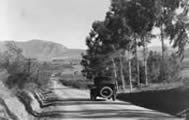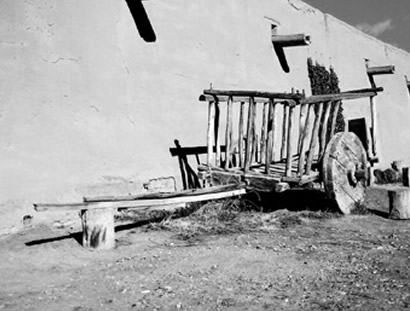|
A Taos-made oxcart--"carreta."
by Albert Simonson
It could be said that San Diego’s back country, a century and a half ago, was the Detroit of Southern California. That may sound absurd, but we have it on good authority that it was so. Famous San Diego pioneer, E.W. Morse, said as much.
The “universal vehicle” of the day was the “carreta,” or oxcart, with big solid wood wheels to manage atrocious roads of the day. All you needed was an Indian to steer by walking in front of the oxen and regular lubrication by a “greaser,” with a bucket of animal fat. And high-octane Viejas barley for fuel.
Morse said the carts were manufactured on the Viejas rancho, where the casino now is. This made sense. First, the Viejas rancho was the county’s prime grain producer for the newly-arrived U.S. Army. Second, nice straight timber was available as close as Descanso, for axles and framework. That’s how we got long trains of barley-laden oxcarts rumbling down the Camino de Secuán (Sycuan) toward the grain market in San Diego’s New Town (present downtown).
Of course, import models were available from Spain, but they had spoked wheels which didn’t stand up to California road standards. The local models had solid timber wheels and ox hide flooring, rugged enough for our roads. For springs, you had straw, complementing the natural elasticity of your buttocks. On Greek and Turkish models, the wheels and axle rotated as a unit. They don’t corner well, but are good on the straightaway.
Old maps and aerial photos show the route from Viejas Valley on down to Spring Valley and San Diego. Stone walls in Alpine evidently enclosed a grain field, and there is some suggestion that this was a staging area for trains of oxcarts headed down to San Diego. From San Diego, much of the grain was sent by wagon train to Fort Yuma, by way of Warner’s Ranch and Vallecito.
The great enterprise came to an end in the mid-1850’s, when the Army Quartermaster Corps found cheaper grain supplies further north in Benicia. At the same time, new shallow-draught steamboats became able to resupply Fort Yuma by way of the Sea of Cortez, putting the overland wagon trains out of business.
The Gastelum family of Ensenada took an oxcart vacation all the way up to Sonoma. It took them two years, but of course they dropped in for visits at every rancho along the way. Visitors were always good news since nobody had CNN.
You can still see oxcarts at some of the old missions. If you’d like to have one of your own for your front yard or parades, there is a man in Taos who still practices the lost art with extremely seasoned wood and cowhide thongs. His carts have the patina of age.
Not only would it look impressive wobbling through town behind a beefy team of oxen, but it would also be environmentally friendly. With 100% organic tailpipe emissions, it would be way better than a big new SUV like the Ford Exterminator or the Extinction. And it would send a message that we are serious about our air quality and speed limits.
An important part of your oxcart equipage will be the ox. Little oxlets are not just born, but must be fashioned through another lost art, a description of which might be inappropriate in a family newspaper read by persons of delicate sensibilities. It takes a firm but intimate hand to turn a heifer-craving rambunctious bull into a sweet-mannered ox. Naturally, the man who can do it deftly earns the respect of his fellow man. And the respect of bulls too.
|




